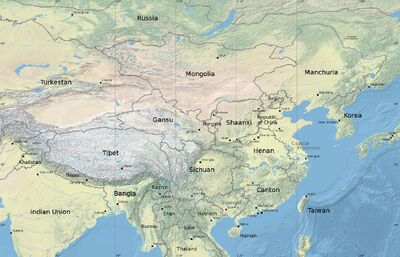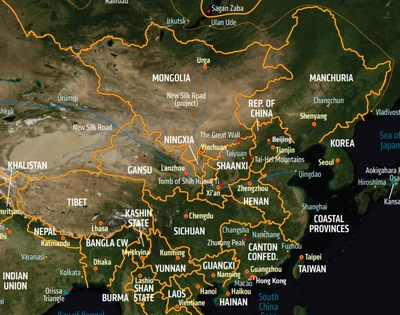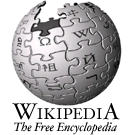
Map of East Asia
CC-BY-NC

China is no longer a country, but a region occupied by dozens of splinter states all warring with each other. Four of the larger states (the Canton Confederation, Henan, Shaanxi, and Sichuan) are vying to reunify China under their respective banners, while the other lesser states serve as political wildcards.
History
Background
Arguably China's demise could be said to originate in the market reforms by Deng Xiaoping into the Chinese Communist economy. As the Chinese economy grew and expanded through the 80s and 90s and into the Resource Rush, several of the southeastern Chinese provinces, close to Hong Kong and Macao and with emigrant connections to southeast Asia and the United States, began making individual deals directly with their trading partners. In 2006, the provinces of Guangdong, Fujian, Jiangxi, Hunan and Zhejiang banded together to form the Greater Canton Economic Development Council, a trade alliance to coordinate economic deals with the provinces. The central government gave tacit approval, as the Council was bringing in money and saying all the right words about Party loyalty. On the other hand, the move also alienated a number of western provinces, most notably Sichuan, which resented all the attention the eastern provinces was getting from Beijing.
The unraveling of China, however, didn't begin until 2011, when a magical barrier known as the Veil fell over most of Tibet, as well as other portions of Qinghai and the Himalayas, cutting off that region from Chinese control. Attempts to penetrate the Veil and re-exert control by the PLA failed.
Emboldened by this failure, the western province of Xinjiang, which consisted mostly of Islamic Uighurs rather than Chinese Han declared its independence from China in 2013. Already plagued by post-Awakening problems and their failure to resolve Tibet, Beijing had little choice but to watch them leave. Xinjiang subsequently merged with other Central Asian Islamic states to form the nation of Turkestan.
In 2015, Hong Kong declared that the policy of "one country, two systems" was not working out and that they were intending to opt out of the system. With the help of Great Britain and the nascent extraterritorial megacorporations, the territory renamed itself as the Hong Kong Free Enterprise Zone, a corporate enclave run by the megacorps.
The unraveling of China picked up speed when an earthquake in the Taihang Mountains buried China’s primary nuclear arsenal, detonating a few warheads in the process. With the Party deprived of most of its nukes, the member states of the Canton Development Council withdrew en masse and formed the Canton Confederation. Sichuan and Shaanxi also formed their own nations, dissatisfied with the Party’s preferential treatment of the eastern Coastal Provinces. All these secessions created a corridor of independence that cut off the other western provinces, which subsequently went their own way. Most important, the withdrawal of these provinces created a crisis of confidence that resulted in a coup, throwing the Communist Party out of power in China. In its stead the New Progress Party took control, consisting of businessmen and rising apparatchiks kept outside the Communist Party leadership by the old guard, renaming the country as the Republic of China.
Republic Civil War
Upon taking power, the New Progress Party renamed the regions Beijing still held onto as the Republic of China and initiated purges to politically obliterate the old guard. A core of hardliners managed to regroup and solidify power in Henan, however, and loyalties were divided from prefecture to prefecture in the remaining eastern Coastal Provinces. Some supported the New Progress Party, while others remained faithful to the old-line communists.
The result was an eight-year civil war that split the eastern coastal regions into microstates. These small, weakened mini-nations received support from various extraterritorial AA and AAA megacorps, who manipulated them into loosening anti-sweatshop regulations. This region of microstates eventually came to be known as the Coastal Provinces.
Meanwhile, the residents of Manchuria, with the aid of urban spirits, used the chaos to withdraw from China. Once the dust settled, the Republic of China was a rump state.
Timeline
2006: The provinces of Guangdong, Fujian, Jiangxi, Hunan and Zhejiang form the Greater Canton Economic Development Council, to deal with the increased foreign investment and economic boom caused by the Resource Rush.
2011: Tibet withdraws from China and erects a large magical barrier isolating it from the rest of the world.
2013: Xinjiang secedes from China.
2015: Hong Kong secedes from China and declares itself the Hong Kong Free Enterprise Zone. Great Britain is duped into using its influence to aid Hong Kong, but corporate interests swiftly take over.
2017: A major earthquake hits the Tai-Hei mountain range, which also serves as China’s main nuclear weapons stockpile. The quake triggers several underground nuclear detonations, which collapse the entire underground arsenal. Aftershocks reverberate throughout northern China; one creates deep crevasses in Tiananmen Square and topples several monuments.
2018: The member provinces of the Greater Canton Economic Development Council secede from China, and the Council transforms into the Canton Confederation. Sichuan, Shaanxi and Inner Mongolia also withdraw, effectively cutting off western China from Beijing and prompting the western regions to secede. These sudden losses force a coup in Beijing, as reformers throw the Communist Party out of power.
2019-2027: Republic Civil War. Fighting breaks out as the communists regroup in Henan and attempt to regain control of Beijing. The provinces between the Yellow River and the Canton Confederation splinter into microstates, forming the Coastal Provinces region. Communist hardliners solidify their hold over Henan and withdraw it from the Republic. Henan absorbs a portion of Hubei Province, while the province of Shanxi merges with the independent Shaanxi state. Manchuria also withdraws from the Republic of China.
2021: The Sichuan provisional government collapses as incursions from its neighbors spark civil unrest. Intermittent warfare disrupts the Chinese heartland.
2039: Monarchists seize control of Shaanxi and restructure it as a parliamentary monarchy. Michelle Chou is crowned Queen of Shaanxi.
2041-2044: Nationalist War. Fujian and Zhejiang declare independence and break away from the Confederation to join Taiwan. The Confederation wages war and reclaims Fujian. Zhejiang fragments into multiple microstates that are subsequently lumped into the Coastal Provinces.
2044: The mage Liang Hong seizes power in Sichuan.
2047: Sichuan annexes most of Guizhou and parts of Yunnan.
2060: Li Tianiz organizes a coup in Beijing that forces out the republican government. Occupying the Forbidden City, he declares himself Emperor.
2061: The Republic of China and Emperor Tianzi sign a peace treaty, in which the republic recognizes Beijing as an autonomous region politically independent from the Republic. The Republic capital moves to Tianjin.
2062: The great dragon Lung lands on Mount T'ai Shan and declares it his lair.
Territorial evolution of the Chinese successor states
See Territorial evolution of the Chinese successor states
Culture
Connections
Guanxi (connections) is what is most important in China when it comes to doing business. The strongest guanxi is of course, family. Not just your immediate family (parents and siblings) but also your grandparents, their siblings, the in-laws, and even cousins thrice removed. Make an enemy and you may end up with over a 100 people after you.
Hierarchy
In China, hierarchy in society is important as in knowing who is your better. Confucianism strongly influenced Chinese civilization and it was big on every individual knowing their place in society. People keep a virtual social scorecard and maintain a tally in their head as to who scores higher.
Etiquette
Among the Chinese, etiquette is important, as in how polite this or that person acts. The Chinese learn pretty early that they are supposed to be courteous to each other. As in being courteous to others even when your ripping them off. There is also the concept of "face" which deals with your honor, reputation, street credibility, and so on. If you screw someone over, it's advisable to give that individual the opportunity to restore his reputation, otherwise you will make an enemy.[1]
Sixth World in China
Metahumans
Though things were not all roses for metahumans when they appeared in China (e.g. parents abandoning ork and troll children), due to cultural factors the Han Chinese were more easily able to accept the emergence of metahumans than people in Japan, India, the Middle East, or some of the more conservative regions and nations in the West (e.g. the Confederation of American States or Spain). The treatment of metahumans is generally likewise better than in most of the world, especially compared to the CAS, Japan, or the Middle East. This is reflected in the Chinese megacorp Wuxing, Inc., their criminal syndicates (Triads), and in both Daoism and Buddhism.[2][3][4][5][6]
Awakened
Magic was embraced by the Chinese relatively easily due to it's acceptance in Daoism, Buddhism, and Confucianism and therefore its reintegration into Chinese society was far easier than it was in the Islamic nations or in most of the Catholic world. The Awakened are favored in Chinese society and the use of magic in society is greater than in the West as demonstrated by Wuxing, Inc., states such as Sichuan and Manchuria, the respect and reverence for dragons, the Triads, or the city of Hong Kong.[7][8][9][10][11]
China Politics and Geography
China has fragmented into a number of major and minor splinter states, as well as regions of microstates or lawlessness which have no central control.
The major splinter states represent the more powerful states of what used to be China. With the exception of Manchuria, all of the major states possess a share of China's nuclear arsenal and to varying degrees are vying to reunify China under their own leadership.
The minor splinter states are smaller regions that still manage to retain their own autonomy.
The regions listed below have no central government or authority, but are rather collective regions of microstates, warlord holdings, or lawless areas.
Successor States
- Major States
- Minor States
- Other Regions
Major Corporations
Major Triads
- Red Dragon Association
- Smoke Circle Society
- Black Chrysanthemum
- White Lotus Society
- Phoenix Lodge
- Onyx Turtle Lodge
- Ten Thousand Lions
- 289's
- Bronze Jian Triad
- White Tigers
Magical Powers
- Lung, the Great Eastern Dragon
- Chiao, Eastern Dragon
- Bai Zhenzhu, Eastern Dragon
- Yat Gwan, Eastern Dragon
- Order of Zhang Daolin
- Discordant Harmony
China before the Modern Era
Historically, China has been the center of one of the world's leading civilizations and the home of one of the greatest empires that man has created. From the times of the ancient Greeks to the beginning of the Renaissance, it was the world's leading technological power, rivaled only by the Romans and the Hellenistic kingdoms of the eastern Mediterranean, a nearly two thousand year period.[1] China likewise was one of the leading economies of the world, usually number one or two, from the time of the Romans till the American War of Independence. During that time it was usually India that rivaled China in the size of its economy.[2]
The Chinese empire was the longest, continuous empire in the history of mankind (from its unification in 221 BC to 1912 AD the fall of the Qing) which was over 650 years longer than the Roman Empire (from its founding in 27 BC to 1453 AD, the fall of Constantinople). Most of the time it was under the rule of Han Chinese dynasties (except for the Mongol Yuan and Manchu Qing). During which time the rule of the Han Chinese dynasties extended as far west as into Central Asia reaching the Aral Sea and going into Afghanistan (Han and Tang dynasties), and as far north as the border regions of southern Siberia (Tang dynasty). The Tang dynasty conquered the steppe empire of the Turks (Gokturk Khanate which ruled Mongolia, Xinjiang, and Central Asia) and before it the Han dynasty conquered the steppe empire of the Huns (Xiongnu whom ruled Mongolia and Xinjiang).[3][4][5]
Vietnam was conquered by the Han dynasty and ruled by China for over a thousand years, was conquered again centuries later by the Ming who ruled it for a few decades, and for most of its history was a tributary of China. Korea was conquered by the Tang dynasty and ruled by China for a few decades, and for most of its history was a tributary of China. During the Han dynasty, the Kushan Empire of northern India and Pakistan was a tributary state. The Ming dynasty's naval power was such that for decades in the 15th century, nearly every coastal state in Southeast Asia, the Indian subcontinent, the Persian Gulf, the Arabian peninsula, and East Africa paid China tribute. Before it during the Song Dynasty, China had naval primacy in the East China Sea and South China Sea. Japan itself was a tributary state of China during the Tang and Ming dynasties, though only for a few decades.[6][7][8][9]
References
- ↑ Shadows of Asia p.25
- ↑ Corporate Download p.108
- ↑ The Complete Trog p.78-79
- ↑ Vice p.66
- ↑ Vice p.68
- ↑ Shadows of Asia p.207-208
- ↑ Shadows of Asia p.45
- ↑ Shadows of Asia p.207-208
- ↑ Runner Havens p.9-10
- ↑ Shadowrun Fifth Edition Core Rulebook p.34
- ↑ Vice p.68
The Great Dragon Lung is rumored to lair somewhere in mainland China (sr3.269).
Most heavy industry controlled by Mitsuhama (cd.63).
Reference to "the China Democracy" (sea.147).
Aztechnology owns the Jiuquan launch facility in Gansu (yotc.18).
This page forked from Wordman's The Sixth World: A geographical index to the world of Shadowrun
Index
- Portfolio of a Dragon: Dunkelzahn's Secrets, 77
- Shadowrun Third Edition, 29
- Shadows of Asia
- Underworld Sourcebook, 53
- The Complete Trog, 78-79
- Corporate Download, 108

|
This page uses content from Wikipedia. The original article was at China. The list of authors can be seen in the page history. As with Shadowrun Wiki, the text of Wikipedia is available under the GNU Free Documentation License. |
| The Splinter States of China |
|---|
|
Beijing | Canton Confederation | Coastal Provinces | Gansu | Hainan | Henan | Hong Kong | Manchuria | Ningxia | Shaanxi | Sichuan | Taiwan |
